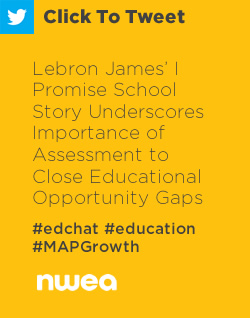 The New York Times featured a story on the I Promise School in Akron, Ohio and supported by the LeBron James Family Foundation, which highlighted encouraging initial results for its third and fourth grade students on NWEA’s MAP Growth assessments. By design, the school serves students who struggle academically. But in many ways, this story is about students and schools across this country and of how assessment can support educators working to help all students learn and grow. As a researcher, here are three things that stood out to me:
The New York Times featured a story on the I Promise School in Akron, Ohio and supported by the LeBron James Family Foundation, which highlighted encouraging initial results for its third and fourth grade students on NWEA’s MAP Growth assessments. By design, the school serves students who struggle academically. But in many ways, this story is about students and schools across this country and of how assessment can support educators working to help all students learn and grow. As a researcher, here are three things that stood out to me:
1. Why multiple measures matter
One key takeaway is the importance of multiple measures. State summative test results may not tell the whole story of student growth, in Akron and elsewhere. Because MAP Growth assessments adapt across grades, they provide crucial and actionable insight into what students know and can do whether the students are performing at, above, or below grade level. This can be especially useful for students who are starting out below grade level. Teachers and students can gain insight into what each student is ready to learn. By assessing multiple times through the year, educators can measure and celebrate growth, see what is working, and where improvement is needed.
2. Putting results in context
The story also illustrates the value of the norms and the important context they provide for individualizing instruction, setting achievement goals for students and/or schools, understanding achievement patterns, and evaluating student performance. NWEA provides both achievement and growth norms for students and for schools. With NWEA norms, educators can see, for each student, what typical growth would be, and if the student is growing faster or more slowly than her/his peers.
3. Choosing the right comparisons
Notably, since variance at the school level is typically considerably lower than for individual students, NWEA school norms also provide important context for comparing school performance. If student norms are used to evaluate schools, the performance of a poor-performing school will be understated and a high-performing one will be overstated. Additionally, because NWEA’s norms use data from a very large number of students and schools, and are weighted using rigorous procedures, I Promise and other schools can compare student and school achievement and growth against a nationally representative sample.
Across the country, there are schools that are supporting impressive student growth, including schools with high rates of poverty. What will be really interesting is to learn what I Promise is doing inside and outside of the classroom to drive such growth in students, most of whom are starting off well below grade level. We’ll have to see if these patterns hold over time to help close educational opportunity gaps.